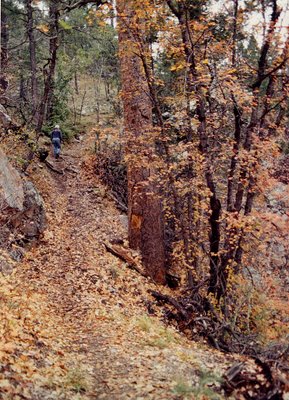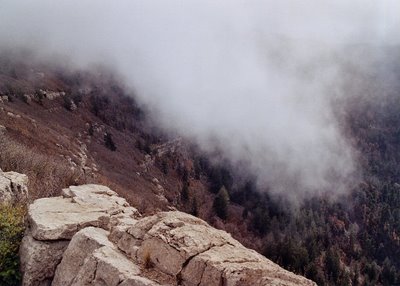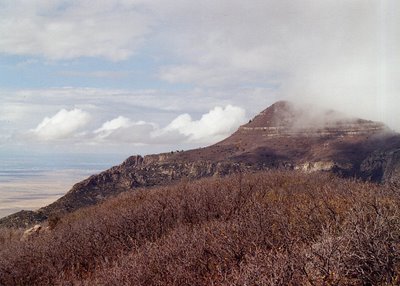Two weeks ago, we headed to Magdalena to visit the Bodios. Unsurprisingly, we ate well and drank much, and saw some brilliant sunsets in joint celebration of two couples' anniversaries. On Sunday, we went out, accompanied by two tazi bitches, to Central New Mexico's Manzano Mountains, a place I had visited previously alone.
The Manzanos are not a mountain range you'll hear much about. They wouldn't do well on postcards or in Sierra Club calenders. They top out at just barely over 10,000 feet, which would be a pretty respectable summit in Idaho or Washington; down here, its not that high, well below the timberline. To put it bluntly, not too many people are interested in these mountains, and I'm optimistic that not many ever will be.
So why should one go, with Colorado's spectacular peaks beckoning not to far to the north? In short: for biodiversity. The Manzanos, particularly in their northeastern quarter, are remarkably well served with rainfall, and the vegetation is explosively lush by Southwestern standards. You sense immediately that you are no longer in the Southern Rockies, as up by Santa Fe. The ubiquitous pinon and juniper are present of course; the nearby Rockies contribute spruce, fir and a few aspens; and the ponderosa pines are very tall and prosperous. But the conifers are largely punctuation set within extensive groves of oak and bigtooth maples. Deciduous trees are always a novelty in New Mexico, and these lush, vast stands of broadleafs are unheard of.
The Manzanos, like their neighbours on either side, are a block-fault range formed by the Rio Grande Rift, asymmetrical, with a steep western scarp falling towards the flats by the river, in contrast to hillier and gentler eastern approaches. As we drove up out of the rift on our way to the trailhead, over Abo pass, rain began falling heavily, steaming the car, defroster struggling and windows cracked. We couldn't see the mountains at all through the clouds and rain as we drove north to the trailhead, our optimism for the hike on the wane. These eastern foothills of the Manzanos were one of the first areas of European settlement in New Mexico outside the Rio Grande valley. The ruins of large churches and extensive settlements are scattered about the area: Abo, Quarai, Gran Quivira. This is the far uphill edge of the Great Plains, and the Indians gathered salt on flat playas to the east for trade. As the story goes, the first Spanish traders who ventured out of the valley seeking the source of the salt found mature apple trees growing here, apple trees whose zeal to colonize evidently outdid that of the conquistadors and missionaries. (Apples, if you've forgotten, come from the Altai mountains in Kazakhstan.)
Some modern settlements hang on out here as well. Estancia and Mountainair are down-at-the-heels high plains towns, with some splendid old brick buildings and ranch houses and not much else, sustained by the railroad and the ranches to the east, flanked on the west by the Manzanos and on the south by the cloven, haunted, empty badlands of the Los Pinos mountains. Closer to the mountains are several Spanish land grants and their eponymous villages, Punta de Agua, Manzano, Torreon and Tajique, beautifully run-down Spanish villages laced with seasonal creeks from the mountains, of the sort that have mostly been bought out by yuppies up north. We drove past perfect village churches, skeletons of gers, hogans, undefinable structures, general stores; there's a Sufi center outside of Torreon. At Tajique we hung a left up a canyon of high plains sandstone strata tilted up by the rift, into increasingly opulent vegetation.

 The rain broke. We walked uphill towards the crest. The tazis pushed ahead, but even they were largely kept to the trail by the dense oak underbrush. We had come hoping for fall colours in the state's best deciduous wood. We found a little bit of everything: lots of bare trees, the ground strewn with brown; lots of lush green stands looking determined not to acknowledge autumn one bit; and a few brilliant splashes of orange and red fall brilliance. When I had come here before, in late summer, there had been many wildflowers. A few lingered on under the autumn canopy: Jacob's ladders, harebells, many I didn't know. Small, trickly waterfalls in the gullies provided a soundtrack.
The rain broke. We walked uphill towards the crest. The tazis pushed ahead, but even they were largely kept to the trail by the dense oak underbrush. We had come hoping for fall colours in the state's best deciduous wood. We found a little bit of everything: lots of bare trees, the ground strewn with brown; lots of lush green stands looking determined not to acknowledge autumn one bit; and a few brilliant splashes of orange and red fall brilliance. When I had come here before, in late summer, there had been many wildflowers. A few lingered on under the autumn canopy: Jacob's ladders, harebells, many I didn't know. Small, trickly waterfalls in the gullies provided a soundtrack.
We had also come hoping to see birds of prey at the crest. Early October is raptor migration season, indeed Hawkwatch maintains a seasonal site in the Manzanos, but as we ascended through thick tendrils of mist worthy of a Chinese landscape, our hopes for birds diminished. We did see bear excavations in the soil.

Toward the crest, the larger trees thinned out, leaving only a head-high carpet of dense scrub oak. We were not optimistic about views, but as we reached the top the mists began rolling back as if on request, and we looked down the steep western slope of the mountains, striped with limestone terraces, to the broad plain stretching out toward New Mexico's great river. Steve, with his almost supernatural radar for avian life, picked out two sharp-shinned hawks at the top; I caught a fleeting glimpse of the second as it vanished into fog.

 As we descended, the mist moved back in and threatened more rain.
As we descended, the mist moved back in and threatened more rain.
